Surfing in Iceland: A Comprehensive Guide
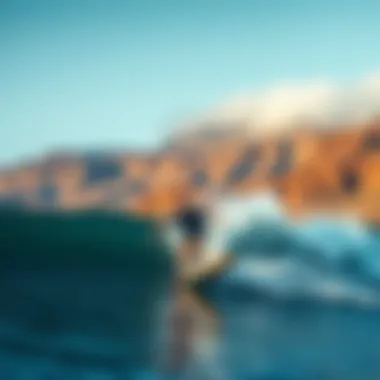
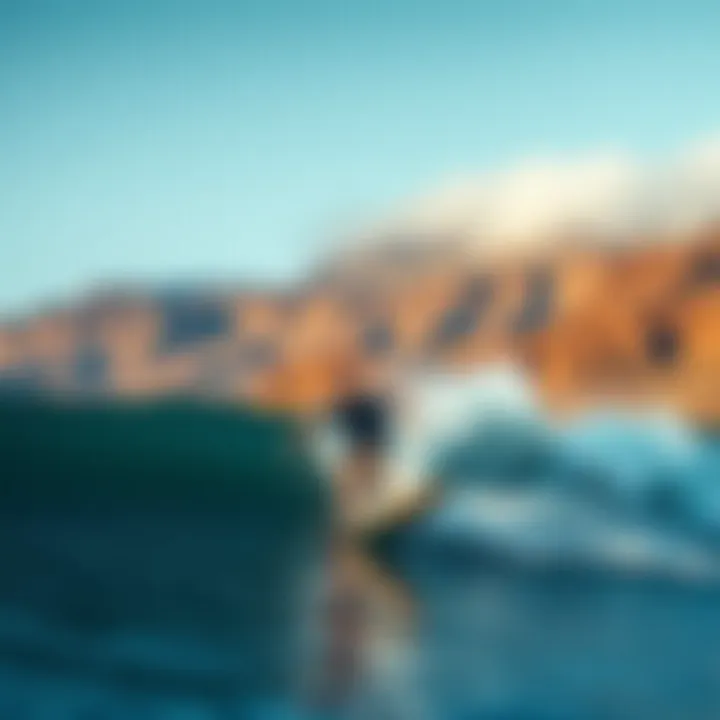
Intro
Iceland, with its dramatic landscapes and powerful nature, offers an experience that goes beyond the traditional surfing destinations. The unique geography, shaped by volcanic activity and glacial movements, creates some compelling surf opportunities. Surfers flock to this remote island not just to ride waves but to immerse themselves in the wild beauty and contrasting elements of land and sea.
While many may associate surfing with warmer climes, the Icelandic surf scene has its own charm. Glacial blue waters, craggy cliffs, and the northern lights create a backdrop unlike any other. This guide aims to navigate the intriguing waters of surfing in Iceland, highlighting the essentials for both budding surfers and seasoned pros. Each section will cover the techniques, gear, and environmental aspects that contribute to this exhilarating activity, all enquanto respecting the delicate ecology that defines this island paradise.
Whether you're an instructor hoping to pass on your knowledge or a traveler seeking a fresh adventure, the information contained within this exploration promises to equip you with insights to appreciate surfing in Iceland more fully.
Techniques and Tips
Surfing in Iceland demands not just physical skill but also a familiarity with the peculiar environment. Here, waves can appear more challenging, and unpredictable weather makes it essential to be prepared.
Essential Surfing Techniques for Beginners
For those new to surfing, the first step is to familiarize yourself with the board and the ocean. Here are pointers to get you started:
- Paddle Out: Ensuring that you can paddle efficiently is key. Use your arms and legs to propel yourself forward.
- Positioning: Find yourself in the right spot to catch the wave. A good rule of thumb is to be slightly behind the peak.
- Pop Up: Once the wave begins to lift you, pop up onto your feet quickly. A fluid motion will help maintain balance.
- Finding Balance: Focus on your core and lower body. Use your arms for balance but avoid flailing them around.
- Practice Timing: Understanding when to take off is crucial. Watch the waves; timing comes with experience.
Advanced Maneuvers for Experienced Surfers
For seasoned surfers looking to push their limits, Iceland has waves that challenge even the best. To excel here, consider honing the following techniques:
- Tube Riding: Catching a wave and riding inside its barrel is a coveted experience. To achieve this, anticipate the wave's direction and angle your board accordingly.
- Carving: Solid carving skills allow you to maneuver rhythmically across the face of the wave. Lean your weight into turns for sharper angles.
- Aerial Tricks: If conditions allow, pulling off aerial maneuvers can enhance your ride. Start with small jumps and progress to flips as you gain confidence.
"Surfing is not just a sport; it's about being part of nature, understanding it, and respecting its power."
Gear and Equipment
To surf in Iceland, having the proper gear is non-negotiable. Due to the chilly waters, appropriate attire ensures comfort and safety.
Essential Surfboards for Iceland
Depending on your skill level and the conditions, the right board can make a difference:
- Shortboards: Ideal for quicker maneuvers and faster waves, these are suited for skilled surfers.
- Longboards: Great for beginners, providing stability and ease of paddling.
- Fish Boards: These can be a fun choice for intermediate surfers, especially in smaller to medium waves.
Must-Have Accessories for Every Surfer
Beyond the board, other accessories can enhance your experience:
- Wetsuits: An essential piece of gear, a good wetsuit should be thick enough to keep you warm in frigid waters.
- Booties: These provide extra warmth and protection from sharp rocks.
- Leash: A sturdy leash ensures that your board stays with you, avoiding any accidents in the water.
- Gloves: To protect your hands from the cold, gloves can be a game-changer during winter surfs.
In summary, surfing in Iceland presents a distinct blend of breathtaking scenery and thrilling challenges. With the right skills and gear, surfers can engage with the waves in ways that few other places can offer.
Prelims to Surfing in Iceland
Surfing in Iceland may not be the first thing that springs to mind when thinking about surfing destinations, but its unique geographical and climatic characteristics infuse the sport with an allure that’s hard to resist. This article aims to highlight why surfers, both seasoned and novice, should be intrigued by the waves that Iceland has to offer. The craggy cliffs, dramatic coastlines, and icy waters create not just a surf spot, but an experience remarkably different from the warm beaches often associated with surfing.
The beauty of Iceland is that it presents a plethora of challenges and wonders, making it a canvas for adventure seekers. With its rich culture and unspoiled nature, surfing here transcends the mere act of riding waves; it becomes an exploration of elements and ecosystems. Surfers who dare to dip their toes into the icy waters find themselves part of a community that values not just the thrill of the surf, but also the preservation of a delicate environment.
The Allure of Iceland's Waves
There’s something mesmerizing about the waves in Iceland. They have an untamed quality, influenced by the northern winds and the surrounding ocean currents. These waves are not just steep and challenging; they tumble into shoreline rocks and sandy beaches, creating a variety of conditions that cater to different types of surfers. For beginners, the relative softness of some spots allows for a gentle ride, while advanced surfers can test their mettle against powerful swells.
The perception of surfing in frigid waters may deter many, but for those who brave the cold, the experience is marked by stunning views. Imagine paddling out at daybreak, the sun shooting rays across the icy expanse of the sea, with only the sounds of crashing waves for company. It's an atmosphere that cultivates introspection and exhilaration all at once.
An Emerging Surf Destination
While places like Hawaii and California dominate the surf scene, Iceland is slowly carving out its niche. With an increasing number of surfers visiting, the interest in surf culture here is on the rise. It’s not just about the sport anymore; it’s about discovering a lifestyle that aligns with respect for nature, kinship among surfers, and a shared enthusiasm for the unpredictable Atlantic swells.
Surfing spots like the Reykjanes Peninsula and the South Coast are becoming well-known, showcasing not only great waves but also dramatic volcanic landscapes. The surf community is growing, forming close-knit groups that welcome newcomers with open arms. Those who surf here often return for the camaraderie as much as the surf.
Furthermore, as more surf-centric businesses start to bloom—like cafes, surf schools, and rental shops—enthusiasts can expect a thriving experience both in and out of the water. With so many developments, it’s clear that Iceland is not just another stop on the surf map, but a hidden gem waiting for adventurers to discover its depths.
"Iceland is shaping itself as a unique surf destination, blending challenging waves with stunning natural beauty."
By exploring the diverse surf culture in Iceland, this article aims to serve as a comprehensive guide for anyone looking to ride the waves or simply soak in the magnificent vistas that the land of fire and ice has to offer.
Geographic and Climatic Factors
Understanding the geographic and climatic factors that shape Iceland's surf scene is essential for any surfer considering this unique destination. The interplay between the island's topography and its often unpredictable weather holds the key to both the challenges and rewards that await. From towering cliffs and volcanic beaches to the ever-changing tidal conditions, Iceland offers a surfing experience that's unlike any other.
Understanding Icelandic Geography

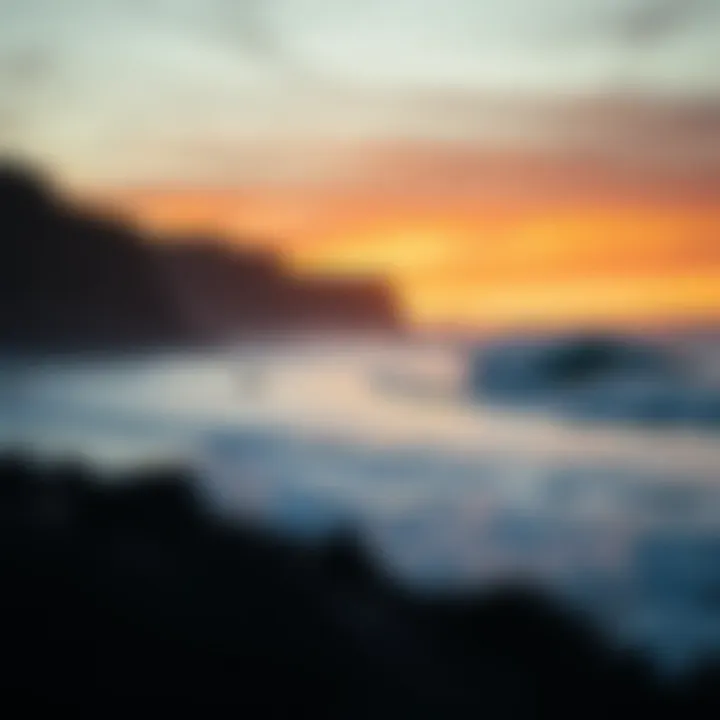
Iceland's geography is a striking blend of the rugged and the ethereal. The island is a product of tectonic activity, resulting in vast lava fields, mighty fjords, and cascading waterfalls. The coastal areas are characterized by black sand beaches and dramatic rock formations, making them visually stunning and diverse for surf exploration.
Surfers will find that the geography affects not just the aesthetics but the surfable conditions as well. Coastal regions like the Snæfellsnes Peninsula and the southern coast near Vik provide various wave types, catering to different skill levels. Additionally, the offshore islands, such as the Westman Islands, promise seclusion and pristine surf conditions away from the crowds. Keep an eye on the ocean currents here; they can be influenced by the geography, leading to both enticing swells and unforeseen challenges.
Seasonal Surf Conditions
Each season brings its unique charm and characteristics, making it possible for surfers to choose their preferred surfing experience. In Iceland, understanding the nuances of seasonal conditions can be the difference between a fruitful adventure and a frustrating one.
Summer Surfing
Summer surfing in Iceland is nothing short of delightful for those looking to enjoy the warmest months. From June to August, the sun hardly sets, and the longer days allow for extended surf sessions. The water, while still chilly, varies from about 9 to 12 degrees Celsius, so a good wetsuit is essential.
A key characteristic of summer surfing is the relatively consistent swell. With the North Atlantic's influence less turbulent than the winter months, it's a more accessible time for beginner surfers to take to the waves. The gentle waves and milder winds create an inviting environment. If you enjoy scenic views while hitting the waves, summer in Iceland allows you to take in the breathtaking landscapes, often dotted with vibrant wildflowers.
However, don't be fooled—summer can have its drawbacks. The increased tourist activity means busier beaches, and finding a quiet spot can be a bit of a challenge. Plus, while the swells are more forgiving, they can also be inconsistent, requiring patience for serious surfers.
Winter Surfing
Winter surfing in Iceland presents a thrilling experience filled with both challenge and solitude. From December to February, surfers brave chilly waters, which can drop to around 3 to 6 degrees Celsius. The experience appeals to many who crave the raw, untouched beauty of winter waves.
A notable aspect of winter surfing is the dramatic conditions. With powerful swells driven by fierce storms in the North Atlantic, experienced surfers can find some of the best waves during these months. The key characteristic is the sheer size of the waves, drawing thrill-seekers looking for excitement.
Despite these advantages, winter surfing isn't for the faint-hearted. The frigid water temperature demands specialized equipment, including thick wetsuits and additional insulation. The isolation felt on the desolate beaches is both enchanting and intimidating. The lack of crowds might be a bonus for many, but it also means that surfers should be hyper-aware of safety and their surroundings.
Wind Patterns
Wind patterns play a pivotal role in shaping the Icelandic surf experience. Iceland's coastal winds can be quite gusty, influencing wave conditions significantly. Surfers often track local reports to understand how wind direction and speed will affect surf conditions on a given day.
A vital factor to consider is the way that winds can create or flatten waves. When offshore winds are prevalent, surfers experience clean, well-formed waves ideal for riding. However, strong onshore winds can lead to choppy waters, making conditions less than ideal for most.
The seasonal shifts in wind patterns also impact weather conditions. In summer months, winds are usually lighter, offering more favorable conditions for surfers. In contrast, winter often brings stronger winds, which may contribute to more challenging surf sessions. Thorough knowledge of these patterns can provide surfers with invaluable insights, enhancing their experience while minimizing risk.
Top Surf Spots in Iceland
When it comes to carving waves in Iceland, the surf spots don’t just offer thrilling rides; they shape the very experience of what it means to surf in this breathtaking country. From the vibrant capital of Reykjavik to the wild beauty of the Snæfellsnes Peninsula, the top surf spots reveal a range of conditions and landscapes that cater to all skill levels. Exploring these locations is more than just a surf trip; it’s about connecting with nature and embracing an emerging surf culture nestled in the ethereal charm of Iceland.
Reykjavik and Surrounding Areas
The capital city, Reykjavik, isn’t just the cultural hub of Iceland, it’s also your gateway to some exciting surf opportunities. Many surfers often overlook it in favor of more remote locations, but the nearby beaches do offer some decent waves, particularly during the winter months when fierce Atlantic swells come to life.
Important Spots in Reykjavik:
- Nauthólsvík: This beach is unique; it even features a geothermal hot tub. The waves here are best suited for beginners, as they allow for some gentle riding without too much danger.
- Kopavogur: Just a stone's throw from Reykjavik, the conditions here are slightly more unpredictable, inviting intermediate to advanced surfers looking to tackle a few challenging waves.
Surfing in Reykjavik is more than just the ride; it's about immersing yourself in the local lifestyle. When you’re finished with your session, the city offers vibrant cafes and quaint shops to recharge, creating a unique blend of surfing and urban exploration.
Snæfellsnes Peninsula
Often dubbed as ‘Iceland in miniature’, the Snæfellsnes Peninsula is a surf haven wrapped in dramatic scenery. This spot combines stunning vistas of volcanoes, glaciers, and beaches, making it an instagrammable paradise while you ride the waves.
One of the standout beaches on the peninsula is Djupalonssandur. The waves here can offer excellent swells, but they come with a touch of ferocity that demands respect. Advanced surfers revel in the challenge it provides.
A surprising gem in Snæfellsnes is Búðaháls, where the rhythmic tides create a mesmerizing surfing experience. With fewer crowds than the popular spots, surfers here often find solitude amid the vast beauty of the untamed landscape.
The South Coast Experience
Heading along the south coast, surfers are treated to a showcase of Iceland’s finest coastal features. From golden sandy beaches to dramatic cliffs, the scenery alone can take your breath away. Notably, Reynisfjara beach, famous for its black sand and basalt columns, also has waves that'll make your heart race. While this location draws a crowd, surfers need to be mindful of the strong rip currents that can arise unexpectedly.
Another noteworthy area along the south coast is Vik, known for its picturesque surroundings and reliable tides. Surfing here can be hit or miss, but the rewards are often worth the wait. Whether it’s early morning beneath the rising sun or during the twilight hours, the experience at Vik encapsulates the mood of Icelandic surfing.
Less Known and Remote Spots
For those with an adventurous spirit, Iceland’s lesser-known surf spots beckon. These hidden gems offer something uniquely special for dedicated surfers willing to wander off the beaten path.
- Ísafjörður: Located in the Westfjords, this spot provides raw, wild conditions perfect for those who crave a more rugged surfing adventure. The isolation enhances the ambiance, making every surf session feel like you’re at the edge of the world.
- Austurströnd: Situated in the Eastfjords, this area is less frequented yet has the potential for magical surf experiences. It’s crucial, however, to come prepared as services are sparse, offering a truly off-the-grid experience.
Finding these spots takes patience and a sense of exploration. They allow surfers to connect with Iceland's unspoiled nature and create unforgettable memories far from the bustling surf spots.
Surfers should keep in mind that while some spots may offer irresistible waves, respect for local conditions and environments is vital.
Surfing in Iceland is not merely a series of activities; it’s about embracing the spirit of adventure and the allure of nature. As you seek out these top surf spots, remember that every wave tells a story, and every location is an opportunity to learn and grow in a sport that connects us to both the ocean and the land.
Surfing Gear: What You Need

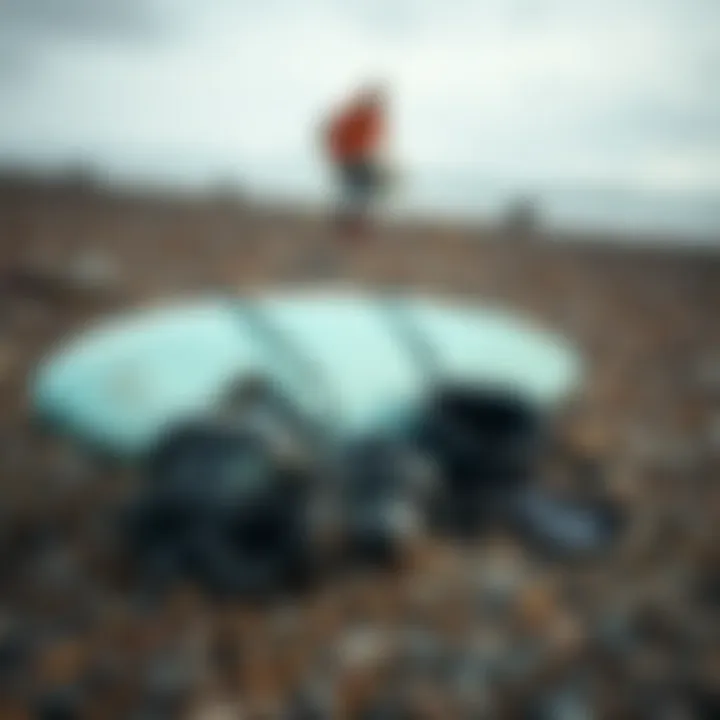
When you think about surfing in Iceland, the images conjured are often of raw beauty and wave action that could put any seasoned surfer's skills to the test. However, the critical role of appropriate gear cannot be understated. The upside of choosing the right surfing equipment can turn an exciting adventure into an unforgettable experience, while mismatched gear can leave you shivering on the shoreline. Let's dig into the essentials you'll need to make your Iceland surf sessions not just manageable, but truly enjoyable.
Wetsuits for Cold Water Surfing
In Iceland, water temperatures can hover as low as 5 degrees Celsius (41 degrees Fahrenheit), even in summer. That’s like taking a plunge into a cold pool on a chilly day! Thus, an effective wetsuit is paramount to retaining warmth and keeping your focus on riding those magnificent waves rather than on the cold that could sap your energy.
A thick, high-quality neoprene wetsuit, typically 5mm or thicker, is recommended. Look for features such as sealed seams to prevent water from trickling in and thermal linings inside to trap heat. A good wetsuit feels like a second skin, allowing agility while providing the cushioning needed against the robust waves. Invest in a reliable wetsuit; it indeed pays off during those icy surf sessions.
Boards Suitable for Icelandic Conditions
Navigating Iceland's surf means grappling with some fierce conditions. A good board can make all the difference. Many surfers opt for a durable shortboard, which is agile and responsive on those powerful waves. However, a fish or funboard could be worthwhile, as they offer more buoyancy and paddle efficiency, especially for the quick takeoffs that windy nights can catch you off guard.
Consider factors such as volume and shape carefully. Alot of Icelandic surfers lean towards boards with a bit of extra thickness, as they float better in the choppy waters. Pay attention to the local surf culture, as shops around Reykjavik might offer a selection tailored specifically to local wave conditions.
Accessories for Comfort and Protection
Boots and Gloves
Surfers often overlook boots and gloves, but they’re just as essential in Iceland as the wetsuit itself. These accessories provide that extra layer of insulation, keeping your extremities warm. Flexible neoprene boots are key as they not only add warmth but also grip when you're darting across rocky shores.
A popular choice among the crowd is a split-toe boot, as it offers a good balance of warmth and board sensitivity. Gloves can be a bit of a conundrum; some prefer finger-less designs for better dexterity, while others swear by full-finger versions for maximum warmth. The main advantage of investing in these accessories is the prolonged comfort they provide, allowing surfers to stay in the water longer without the numbing cold cutting short the stoke.
Hoods and Leashes
Hoods are another vital component of your surfing strategy in Iceland. These items are great for keeping your head warm and ensuring you don't freeze while paddling out. The best hoods are constructed with thermal lining and a snug fit to keep chilly water at bay. Consider getting a hood that's designed to manage water flow, as a good fit can be the difference between comfort and constant discomfort.
Leashes, while often underestimated, are equally important. The leash connects you to your board and can prevent you from losing your board in treacherous waters. Look for a leash made of high-quality materials designed to withstand the fierce conditions Iceland can throw. You don't want to be the surfer who lost their favorite board to the depths of the sea!
A well-thought-out selection of gear not only enhances the experience but can also be a difference between fun and fatigue. Keep your gear organized and inspect regularly, as a little extra care goes a long way in extending the life of your beloved equipment.
In summary, having the right surfing gear is crucial for making the most out of your time in the waves of Iceland. From wetsuits that keep the chill at bay to specialized boards and accessories, every piece plays an instrumental role in your surfing adventure. Plan and prepare well, and the experience will undoubtedly be exhilarating and memorable.
Safety Considerations in Surfing
Surfing in Iceland is not just about catching waves; it's about doing so safely. The unique environment, with its chilly waters and unpredictable weather, requires surfers to be aware of the risks involved. Grasping the importance of safety considerations while surfing in Iceland ensures that you can enjoy the experience to the fullest while minimizing dangers.
Understanding Wave Dynamics
Understanding wave dynamics is crucial in Iceland, where conditions can shift in the blink of an eye. The waves here can be powerful, driven by the winds and the shape of the ocean floor. Knowing how to read the ocean isn’t just helpful; it’s essential.
- Wave Formation: Waves build up differently based on wind speed, duration, and direction. Surfers should pay attention to local reports and how tides impact wave behavior.
- Timing Your Paddle: A little patience goes a long way. Watch how waves break; knowing when to paddle can be the difference between riding a wave and getting overwhelmed.
- Rip Currents: These underwater rivers can be treacherous. Being able to spot one can help a surfer avoid being pulled out to sea. If you find yourself caught in one, don’t panic; swim parallel to the shore to escape its grip.
Local Wildlife and Environmental Risks
When surfing in Iceland, you’re sharing the water with more than just your fellow surfers. The rich marine life adds another layer of excitement—but caution is needed.
- Seals and Birds: Iceland’s waters are home to seals and various seabirds. While these creatures are generally harmless, approach them with respect. Disturbing wildlife can be illegal and detrimental to the ecosystem.
- Fluctuating Temperatures: The cold water can be a shock, even for seasoned surfers. Sweeping changes in weather can also lead to hypothermia if you aren’t dressed appropriately. Always check the local forecast before heading out for a session.
- Environmental Concerns: Pollution and marine debris can pose risks to surfers. Stay aware of the environmental impact of your activities and participate in local clean-up efforts if possible.
Emergencies: Preparation and Response
Being prepared for emergencies isn't just smart; it’s vital. Surfers should have a solid plan in place before hitting the waves.
- Surf Buddy System: Having a friend with you is not only more fun but can be lifesaving. If something goes wrong, having someone to help can make all the difference.
- Emergency Gear: Keep a first aid kit on hand. Familiarize yourself with basic procedures, so you're ready to act quickly in a crisis.
- Communication: Always have a way to communicate, like a waterproof phone case or a buoy to signal for help. Make sure someone knows your surfing location and expected time of return.
If you're stuck or in danger, signal for help with your arms and stay calm. Panic won't help.
By taking these safety considerations seriously, surfers can ensure a more enjoyable and secure experience in Iceland’s stunning but challenging surf. Remember, it's not just about the ride; it’s about going home safe after catching those amazing waves.
Environmental Impact and Conservation Efforts
Surfing in Iceland presents unique ecological challenges and opportunities. As surfers flock to its captivating waves, it’s vital to remember that the allure of Iceland’s surf scene comes with a responsibility to protect its fragile environment. Surfing, while thrilling, has a direct impact on local ecosystems, marine life, and coastal areas. This section dives into sustainable practices and conservation policies aimed at preserving Iceland’s pristine surf spots for future generations.
Sustainable Surfing Practices
Adopting sustainable surfing practices is essential. This goes beyond just having eco-friendly gear; it encompasses a lifestyle and attitude towards the ocean. Here are some notable practices:
- Gear Choices: Opt for environmentally friendly surfboards made from sustainable materials. Some companies now produce boards from recycled materials, helping to reduce waste in landfills.
- Leave No Trace: It’s vital to pack out what you bring in. Clean up beach areas and avoid disturbing wildlife habitats. Proper disposal of trash is a must.
- Educate Others: Share knowledge about sustainable practices with fellow surfers. Community awareness can promote a culture of care towards the environment.
- Carbon Footprint: Consider transportation methods with lower carbon emissions when heading to a surf spot. Carpooling or using public transport can make a significant difference.
Impact of Oil and Fuel Spills
“The beauty of Iceland's surf is undeniable, but with it comes the risk of pollution from oil spills, especially from boats. Regularly monitoring and maintaining the waterways is crucial.”
The thrill of riding ocean waves should not overshadow the responsibility that comes with it. Understanding the consequences of our carbon footprints on the environment is necessary. Simply put, every surfer can make a difference.
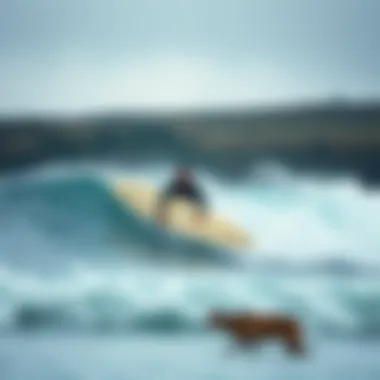
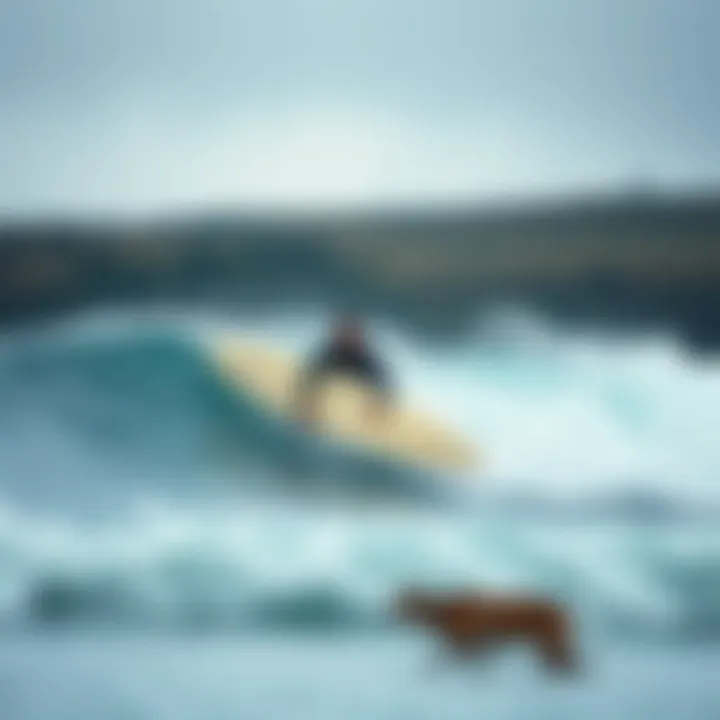
Conservation Policies in Iceland
Iceland has recognized the importance of protecting its environment, particularly in relation to its waterways and surf spots. Several essential conservation policies are in place:
- Marine Protected Areas: Zones designated for special protection from harmful activities allow marine biodiversity to flourish. These areas are vital for sustaining ecosystems where surfing occurs.
- Regulated Fishing: There are rules about fishing practices near popular surf spots to ensure balance in the ecosystem, which ultimately benefits both marine life and surfers.
- Public Awareness Campaigns: Initiatives to promote sustainable practices among both locals and tourists actively work towards mitigating environmental impacts.
- Legal Frameworks: Iceland has established laws targeting pollution and conservation efforts. These provide a foundation for maintaining high environmental standards, ensuring that surfing can be enjoyed responsibly.
By understanding and supporting these conservation efforts, surfers can ensure that they are part of the solution rather than the problem. Embracing these practices will help Iceland's surf culture thrive while protecting the pristine beauty of this unique surfing oasis.
In summary, the responsibility for preservation lies in the hands of those who enjoy Iceland’s surf. By integrating sustainability into the surfing culture and respecting the environmental policies set forth by local authorities, surfers can continue to ride the waves of Iceland without compromising its natural beauty.
Cultural Significance of Surfing in Iceland
Surfing in Iceland goes beyond mere sport; it's a cultural phenomenon shaped by the landscape, community, and evolving traditions. The cold, dramatic waves of this island nation provide not just a challenge but also a connection between individuals and nature. Many surfers feel the call of the ocean is profound. The water here tells a story of endurance, adventure, and a spirit of exploration, drawing both locals and travelers alike.
The Evolution of Surf Culture
Surf culture in Iceland burgeoned in the early 2000s, moving from a niche hobby practiced by a few to a respected pastime embraced by many. Initially, surfing was largely underestimated, with only a handful of enthusiasts navigating the icy waters. Yet, over time, as more adventurers faced the brisk waves, communities began to form. Surfing here isn't just about riding waves; it's also about reveling in sessions against the backdrop of astounding vistas. The camaraderie among surfers is palpable. Folks often share tricks of the trade, like the best spots to catch those elusive swells or the right gear that stands up to the icy conditions. Furthermore, Icelandic surf culture has absorbed influences from the global surfing community—yet it retains a distinct local flavor, incorporating tales of folklore and nature.
Community and Connections
Local Surfer Groups
Local surfer groups play a pivotal role in fostering surfing enthusiasm across Iceland. These tightly-knit communities, often rooted in specific towns or regions, offer a sense of belonging to surfers, new and seasoned alike. Joining a local group means sharing wisdom, arranging meet-ups, and supporting each other during challenging water conditions. The collective knowledge shared helps newcomers quickly acclimate to Iceland's unique surfing environment. This dynamic creates an inviting atmosphere where surfers empower one another.
Key Characteristics of Local Surfer Groups:
- Supportive Environment: Members often come together for training and encouragement, making it easier to master difficult skills.
- Sharing Resources: Many groups have access to local knowledge that is not available in guidebooks. Learning the ins and outs of specific surf spots often hinges on what other surfers share.
- Connection with Nature: Group activities frequently center around environmental conservation, helping to protect the stunning surroundings that make surfing here so special.
Yet challenges exist, too. For instance, localized rivalries can emerge, causing friction among groups seeking to claim certain surf spots as their own.
Tourism and Surfing
Tourism and surfing in Iceland are interlinked, creating a symbiotic relationship beneficial to both sectors. The surge in interest has drawn surfers from all over the globe, bringing a steady flow of tourism that boosts local economies. Events like surf competitions put Iceland on the map as an important surfing destination. However, this boom has its downsides. The rising number of surfers can lead to overcrowding at prime spots, which in itself poses safety risks and environmental concerns.
Key Characteristics of Tourism and Surfing:
- Economic Impact: Local businesses, like surf shops and accommodations, benefit greatly from increased visitor numbers.
- Cultural Exchange: International visitors often engage with local communities, sharing experiences and broadening cultural horizons.
- Awareness of Sustainability: With more surfers hitting the waves, there is heightened awareness of the need to protect the environment. This has ripe opportunities for promoting eco-friendly practices within the surfing community.
Travel Tips for Surfing Iceland
Surfing in Iceland is somewhat like stepping into a breathtaking dreamscape, where rugged cliffs meet roaring waves and spectacular views become a regular backdrop. However, before packing your surfboard and heading off, it is key to understand some travel tips specific to this unique environment.
Navigating the surf scene in Iceland means knowing not just the waves, but also the land itself. In a country known for its stark contrasts and volatile weather, the importance of planning ahead cannot be overstated. Many surfers overlook factors like local conditions, accessibility, and even gear requirements. Here, we will dissect essential tips to ensure a smooth surfing adventure in this mesmerizing destination.
Best Time to Visit
Timing can make or break your surf experience in Iceland. Surfers usually find the sweet spot between late spring and early autumn—this is when the weather is more manageable, making it easier to immerse oneself in the surf culture without taking too much of a beating from the elements.
Summer months (June to August) are particularly delightful due to milder temperatures and extended daylight, sometimes including the famous midnight sun. Riding waves under a sun that barely sets creates an unforgettable experience. Plus, the swell tends to be more consistent during this time, providing ample opportunity for both beginners and seasoned surfers.
However, the fall months (September to November) shouldn’t be dismissed. They bring bigger swells, which can be a playground for more advanced surfers. The sheer power of the Atlantic begins to take hold, making for thrilling rides. Be ready to face more dresy conditions; it's almost like an initiation into the hardcore surf scene of Iceland.
Here are some key points for the best time of your visit:
- Mild weather is typical during summer, allowing easier access to various surf spots.
- Fewer tourists are likely in early autumn, giving you more space in the water.
- Greater wave heights in fall for those looking for more challenge.
Navigating Transportation and Accommodation
When it comes to getting around in Iceland, having a plan is essential. Renting a car is preferred by many surfers for its flexibility, especially if you’re keen on exploring numerous surf spots. The road trip along the South Coast is especially rewarding, offering incredible scenery that feels straight out of a postcard.
Finding the right accommodation is another vital aspect. Many surfers enjoy staying in guesthouses or hostels in Reykjavik before heading off to the iconic surf locations. This city is not just the capital; it's the hub of surf culture too. You can meet fellow enthusiasts here and even find some surf schools offering classes for various skill levels.
For those looking to stay closer to surf spots:
- Camping is popular, especially during the summer when the weather allows for it. Many campsites offer basic facilities.
- Stay in Airbnbs or cozy cabins for a more home-like feel, particularly if you're traveling with a group.
- Pay attention to sites specializing in surf-specific lodgings; often, these areas have the extra amenities you might need.
In summary, being educated about travel logistics can help you dodge some common bumps along the road, literally and figuratively. Preparing in advance—whether it's knowing the best time to ride the waves or figuring out the best way to explore the rugged terrains—ensures your surfing Iceland experience will be enriched, memorable, and downright exhilarating.
"The biggest adventure you can take is to live the life of your dreams."
Embracing the Icelandic surf culture will add layers to your experience, building connections with locals and fellow surfers, getting involved, and understanding this enchanting land a bit more deeply.
End
As we wrap up our dive into surfing in Iceland, it’s vital to consider the ramifications of this fascinating frontier in the surfing world. The burgeoning surf culture here is not just a quirk of geography; it represents a blend of passion, adventure, and nature’s raw beauty. From the moment surfers dip their toes in the icy water, they become part of a dynamic experience shaped by Iceland's rugged landscape and unique weather patterns.
The Future of Surfing in Iceland
Looking ahead, the future of surfing in Iceland appears bright yet filled with challenges. As more enthusiasts flock to the shores, the need for sustainable practices comes to the forefront. Surfers and local authorities should work hand in hand to protect these stunning environments. Here are some points to consider:
- Increasing Popularity: As the word spreads about Iceland’s unique surf conditions, a rise in surfers can be expected. This guide serves as an invitation to discover what makes Iceland special while advocating for responsible surfing practices.
- Environmental Awareness: Each wave ridden need not swamp the already delicate ecosystems. The conversation around low-impact surfing and environmental conservation is more crucial than ever. This will not only safeguard the natural beauty of Iceland but enrich the surfing experience.
- Community Engagement: Bringing together surfers from around the globe fosters a strong sense of community. Engaging local groups can create a tighter bond between surfers and the native culture, producing a richer experience for everyone involved.
- Advances in Gear: As the sport evolves, so do the technologies and materials used in surf gear. Innovations to enhance thermal protection while minimizing environmental impact will be key to attracting new surfers and ensuring their comfort in chilly waters.



